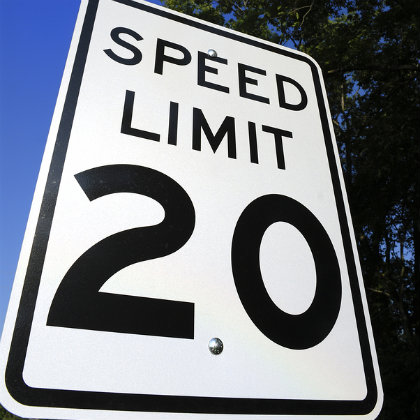The Boston City Council is considering reducing the speed limit to 20 MPH in Boston.
The council discussed the potential decision during a hearing Tuesday morning. The council is considering creating “safety zones” in various areas of the city where they would reduce the legal speed limit. If they do a city-wide reduction of the speed limits, they would need approval from the state but would not need approval with safety zones.

City Councilor Frank Baker, who is in favor of reducing the speed limit, said doing so is one step closer to safer streets in the city.
“This is a good first step,” he said. “I have always thought the speed limit should be 20 but there are more things we need to do.”
City Council Ed Flynn said pedestrian safety is one of his main concerns.
“A day doesn’t go by where someone doesn’t tell me about close calls at crosswalks and speeding cars,” he said.
In January 2017, Boston lowered its default speed limit on most streets from 30 to 25 mph. Before the change was made, a study showed there was a 50 percent chance of a pedestrian suffering a fatal injury in a crash. According to the city, there were 14 fatal crashes in the city, which was a decrease from 2016.
The council also talked about raising sidewalks and other changes they could make to help pedestrians feel safer.
“This needs to happen now,” said Baker.




Make it whatever they want. People can ignore 20 just like they do 25.
Exactly, what difference will it make?
A significant difference. The data from the last reduction are here:
https://www.iihs.org/frontend/iihs/documents/masterfiledocs.ashx?id=2168
Let me summarize for you. When Boston lowered its speed limit to 25MPH there was a 29.3% reduction in vehicles exceeding 35MPH. And an 8.5% and 2.9% decrease in vehicles exceeding 30 and 25MPH respectively.
The conclusion from the study:
“Lowering the speed limit in urban areas is an effective countermeasure to reduce speeds and improve safety for all road users.”
Good stuff. Thanks.
Then why not just make it 10 MPH?
🏆
We have a winner!
Any pedestrian or bicyclist in the city of Boston aren’t going to buy those “statistics”
The nice thing about data and science is that it doesn’t matter if you believe them or not (even if the words are put in quotes) 😉
If you really want to dispute the study, you’ll need to find fault with the collection or analysis of the data. I suspect that you just don’t understand anecdotal versus empirical evidence though.
Whatever the speed limit is, it should be posted on every street and enforced. I have been asking for a speed limit sign on North Washington for years.
“The speed limit reduction was associated with a 0.3% reduction in mean speeds” I don’t know. That doesn’t sound terribly significant. I think it would be more useful to see a longer term study that looks at accidents themselves before and after such speed limit reductions, which is what the end goal at the end of the day.
That’s because the goal isn’t to reduce overall speeds. The data indicate that the majority of cars were already traveling below 25 before the change and that the change was successful in reducing the number of cars traveling above 25 – especially those traveling above 35.
Looking at total accidents is a good holistic study, but it is useless when measuring the effectiveness of a single change like speed limit since you’d need to normalize for a myriad of factors like cell phone usage, demographic shifts, vehicle shape trends, construction, etc.
The stat I want to see is how many more impaired drivers will be on the road now that pot is legal.?
Adam: Thank you for the interesting comments. Lowering the speed does make a difference and it takes only two or three vehicles to obey the new limit, and all cars in tandem will need to slow down !
You’ll need another study for that Michael D